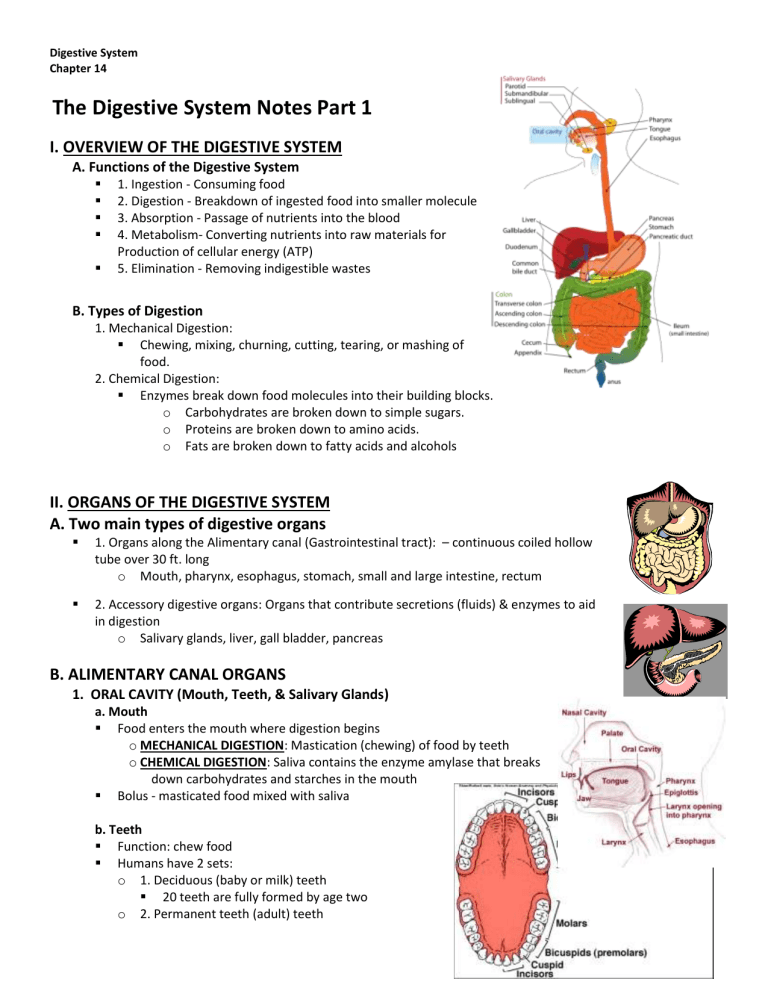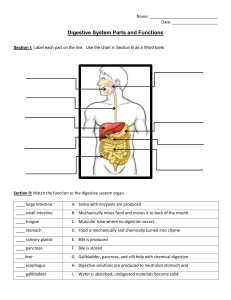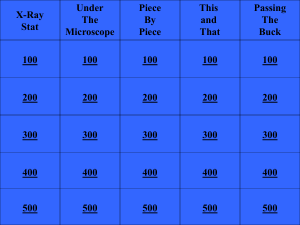
Digestive System Chapter 14 The Digestive System Notes Part 1 I. OVERVIEW OF THE DIGESTIVE SYSTEM A. Functions of the Digestive System 1. Ingestion - Consuming food 2. Digestion - Breakdown of ingested food into smaller molecule 3. Absorption - Passage of nutrients into the blood 4. Metabolism- Converting nutrients into raw materials for Production of cellular energy (ATP) 5. Elimination - Removing indigestible wastes B. Types of Digestion 1. Mechanical Digestion: Chewing, mixing, churning, cutting, tearing, or mashing of food. 2. Chemical Digestion: Enzymes break down food molecules into their building blocks. o Carbohydrates are broken down to simple sugars. o Proteins are broken down to amino acids. o Fats are broken down to fatty acids and alcohols II. ORGANS OF THE DIGESTIVE SYSTEM A. Two main types of digestive organs 1. Organs along the Alimentary canal (Gastrointestinal tract): – continuous coiled hollow tube over 30 ft. long o Mouth, pharynx, esophagus, stomach, small and large intestine, rectum 2. Accessory digestive organs: Organs that contribute secretions (fluids) & enzymes to aid in digestion o Salivary glands, liver, gall bladder, pancreas B. ALIMENTARY CANAL ORGANS 1. ORAL CAVITY (Mouth, Teeth, & Salivary Glands) a. Mouth Food enters the mouth where digestion begins o MECHANICAL DIGESTION: Mastication (chewing) of food by teeth o CHEMICAL DIGESTION: Saliva contains the enzyme amylase that breaks down carbohydrates and starches in the mouth Bolus - masticated food mixed with saliva b. Teeth Function: chew food Humans have 2 sets: o 1. Deciduous (baby or milk) teeth 20 teeth are fully formed by age two o 2. Permanent teeth (adult) teeth Digestive System Chapter 14 Replace deciduous teeth between the ages of 6 to 12 A full set is 32 teeth, but some people do not have wisdom teeth Classification of teeth o Incisors – used for biting food o Canines – used for tearing food o Premolars - (bicuspids) – used for grinding food o Molars – Used for crushing food Parts of a tooth o Crown – exposed part of tooth made of enamel o Neck – connects crown to root o Root – Periodontal membrane attached to the bone, contains blood vessels and nerves c. Salivary Glands Produce saliva - mixture of mucus and serous fluids Helps to form a food bolus Contains salivary amylase to begin starch digestion Dissolves chemicals so they can be tasted 2. PHARYNX The passageway for air and food Has 3 parts: (see diagram) Swallowing: o Reflex that causes the epiglottis to move blocking the trachea (windpipe) o The esophagus opens opens to receive the bolus 3. ESOPHAGUS "Food tube" links the pharynx to stomach the diaphragm Muscle layers contract to squeeze food through the stomach o o Longitudinal inner layer Circular outer layer Peristalsis – alternating waves of muscle contraction 4. STOMACH a. Structure & Path of Food Thick-walled organ located on the left side of the abdominal cavity Bolus (food) enters through the cardio esophageal sphincter o Prevents the backup of stomach acid into esophagus (acid reflux ) Bolus (food) enters through the four regions of the stomach: o Cardiac region – near the heart o Fundic region o Pyloric region – main part of stomach through through to Digestive System Chapter 14 o Pyloric region – funnel-shaped end Chyme (mixture of bolus & gastric juices) exits through the pyloric sphincter into the small intestine MECHANICAL DIGESTION: Muscle of stomach contract to churn and mix food with gastric juices. Deep folds called rugae allow stomach to expand when filled with food b. Coverings of the stomach Peritoneum – membrane that covers the abdominal wall and organs o Visceral peritoneum – covers the organ o Parietal peritoneum – covers the cavity walls Mesentery holds the stomach & intestines in place in abdominopelvic cavity c. Gastric Juices CHEMICAL DIGESTION: Lining of the stomach secretes gastric juices that break food. Gastric juices contain pepsin, HCl, and mucus o Pepsin breaks down proteins into amino acids o Hydrochloric acid (HCl) is a very strong acid (pH 1 or 2) that activate enzymes and kills bacteria o Mucus protects the lining of the stomach from the acidic environment o Replaced every few days o If the mucus layer is broken down by increased acid, an ulcer may form o Peptic Ulcer: Open sores on the lining of the digestive tract that may bleed and be very painful Caused by bacteria (Helicobacter pylori), regular use of pain relievers or other medications The Digestive System Notes Part 2 II. ORGANS OF THE DIGESTIVE SYSTEM (continued) B. ALIMENTARY CANAL ORGANS Review: 1. Oral Cavity (mouth, teeth, salivary glands) > 2. Pharynx > 3. Esophagus > 4. Stomach 5. SMALL INTESTINE a. Overview Muscular tube extending form the pyloric sphincter to the ileocecal valve Up to 22 feet long Functions: Main digestive organ – most digestion occurs in the small intestine Carbohydrate and protein digestion is completed Fat digestion begins Main site of nutrient absorption into the blood b. Structure Small Intestine has 3 parts: o duodenum o First 25 cm, attached to the stomach Digestive System Chapter 14 o Receives secretions from the liver and pancreas to aid in digestion Jejunum o Next 3 feet o Contains folds and villi for absorption o Ileum o Last 6-7 feet o Extends from jejunum to large intestine Walls of the small intestine Has 3 features that increase the surface area for maximum absorption of nutrients o 1. Circular folds – permanent transverse folds in the mucosa and submucosa o 2. Villi – fingerlike projections of the mucosa o Goblet cells in villi produce mucus to lubricate chyme o Villi contain absorptive cells and blood capillaries to absorb nutrients o 3. Microvilli – microscopic extensions from the plasma membrane o o c. CHEMICAL DIGESTION in the Small Intestine Digestion Is completed in the small intestine Accessory organs aid in digestion by secreting enzymes into the small intestine o Bile from the gall bladder Breaks down lipids o Pancreatic juices from the pancreas Sodium bicarbonate neutralizes the acid d. Absorption in the Small Intestine When food has been broken down to its nutrients & waste products, the nutrients must be absorbed by the body Most nutrient absorption occurs in the small intestine. Most substances are absorbed by active transport through cell membranes Lipids are absorbed by diffusion After absorption, nutrients are transported to the cells through the bloodstream 6. LARGE INTESTINE Once digestion & absorption of nutrients is complete, the chyme moves into the large intestine by peristalsis Also known as the colon Larger in diameter, but shorter than the small intestine a. Functions of the Large Intestine Absorption of water Does not participate in digestion of food Digestive System Chapter 14 Eliminates indigestible food from the body as feces Goblet cells produce mucus to act as a lubricant b. Structure Ascending Colon – includes the cecum (saclike structure) with a small projection called the appendix Transverse Colon Descending Colon Sigmoid Colon c. Food Breakdown & Absorption in the Large Intestine Bacteria breaks down indigestible materials o Source of odor o Produce some vitamin K and B o Release gases Water vitamins K and vitamin B are absorbed Remaining materials are eliminated as feces 7. RECTUM Feces moves from the sigmoid colon of the large intestine to the rectum by peristalsis Feces Is stored in the rectum until the involuntary internal anal sphincter is triggered to open Defecation or expulsion of feces occurs when the voluntary external anal sphincter relaxes, and the feces passes out of the body Happens daily Triggered by presence of feces in rectum C. ACCESSORY DIGESTIVE ORGANS 1. PANCREAS Produces a wide spectrum of digestive enzymes that break down all types of food Enzymes are secreted into the duodenum of the small intestine a. Secretions of the Pancreas 1. Pancreatic Amylase: Helps complete digestion of starch 2. Trypsin, etc: Carry out about half of all protein digestion 3. Lipase: Responsible for fat digestion 4. Nucleases: Digest nucleic acids 5. Sodium Bicarbonate: Neutralize acidic chyme Enzymes are transported to the small intestine through the common bile duct (shared with the liver) 2. LIVER Largest organ in the body Has 2 main lobes o Larger right lobe Digestive System Chapter 14 o Smaller left lobe The liver also contributes to digestion by producing bile a. Bile Bile is a greenish substance that emulsifies fat Stored in gall bladder Composed of bile salts & pigments bilirubin from hemoglobin breakdown), cholesterol, phospholipids, & electrolytes Helps to digest fatty foods b. Role of the Liver in Metabolism Removes drugs and alcohol from blood Degrades hormones Produce cholesterol, blood proteins (albumin and clotting proteins) Plays a central role in metabolism Stores products of digestion as glycogen to be released as needed 3. GALL BLADDER Sac found in hollow fossa of liver Stores bile produced by the liver Bile is introduced into the duodenum in the presence of fatty food Gallstones can cause blockages III. Control of Digestive Activity Mostly controlled by reflexes via the parasympathetic division of nervous system Chemical and mechanical receptors are in organ walls that trigger reflexes Stimuli include: o Stretch of the organ o pH of the contents o Presence of breakdown products Reflex include: o Activation or inhibition of glandular secretions o Smooth muscle activity Processes of the Digestive System (See diagram)







